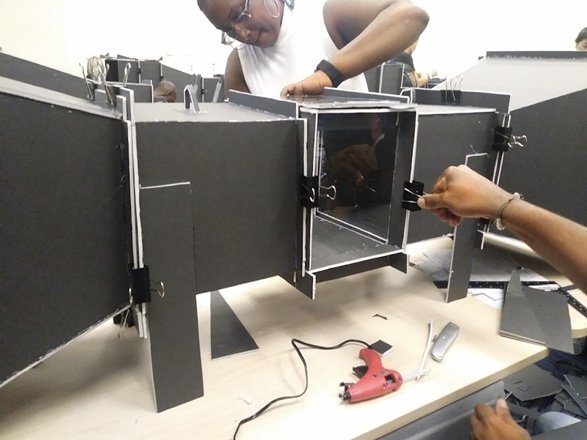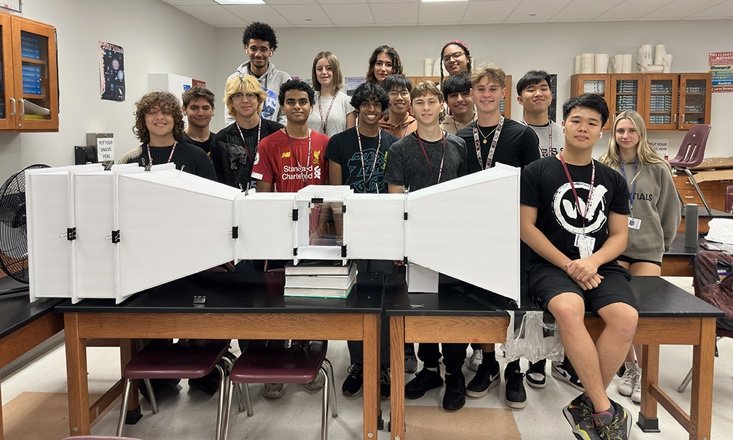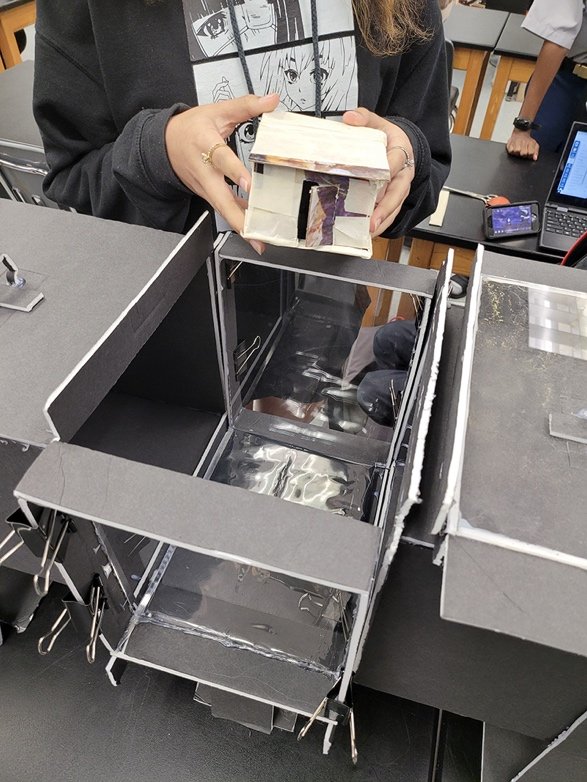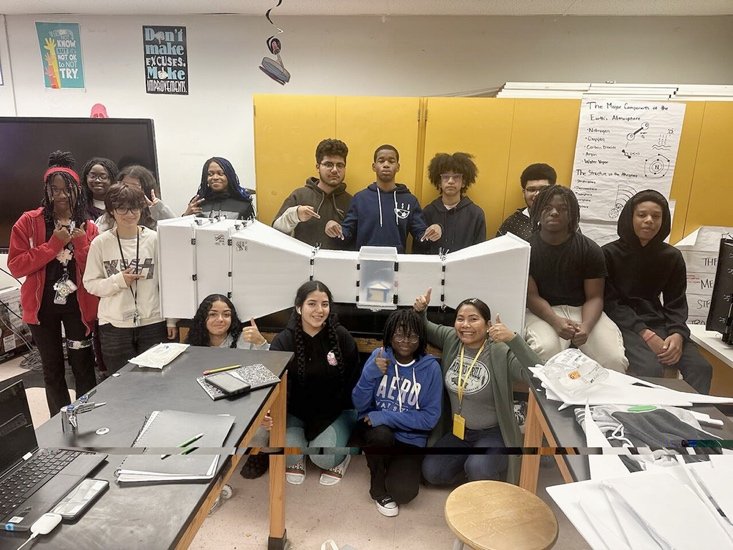FIU, Wall of Wind, Bring Wind Engineering into Florida Classrooms
Annual NSF-funded Summer Programs Train STEM Teachers in Engineering
Published on June 1, 2024, by Erik Salna
Teachers across South Florida are coming to Florida International University to learn about wind engineering — and they’re bringing newfound knowledge into their classrooms. The Wind Engineering for STEM Teachers (WEST) workshop and the Research Experience for Teachers (RET) program are facilitated at FIU for local middle and high school teachers.
The programming is supported by the U.S. National Science Foundation and the Natural Hazards Engineering Research Infrastructure (NHERI) Wall of Wind facility at FIU.
The WEST Workshop is awesome. My students were fascinated about the wind tunnel, and it is a valuable hands-on tool for learning about fluid dynamics after learning about it in a book. The wind tunnel will open doors for more innovative learning in science.”
–Mayleen F. Martin, Environmental Science Teacher, Hallandale Magnet High School
Wind Engineering for STEM Teachers
Teachers participating in the WEST Workshop first tour the Wall of Wind (WOW) facility. They learn how the wind tunnel works and about the research it enables. Then WOW researchers provide lectures on topics such as aerodynamics, fluid dynamics, physical forces, Bernoulli's principle, and the Venturi effect. Additional topics include hurricane science, mitigation, and preparedness. Teachers receive and build a wind tunnel to take into their classroom, a hands-on instructional tool for teaching wind engineering concepts.
During the workshop, the teachers learn how to operate and do experiments with their wind tunnels which prepares them for doing experiments with their students.
WEST teachers also develop a specific lesson plan for using the wind tunnel.

FIU Wind Engineering for STEM Teachers workshop, 2023 cohort

Teachers assembling a classroom wind tunnel at the WEST workshop.
“With the wind tunnel my students were able to apply and explore basic math concepts like inverse variation. With the concept that wind speed will increase when the area is reduced, the students used the instruments to do measurements and see the results on the numbers, which was a neat investigation for the students. And certainly, the students had a blast building and blowing away the different models in the wind tunnel to test which shapes were more aerodynamic.”
–Maite Varela, Mathematics Teacher, TERRA Environmental Research Institute


(Left and Above) Mr. Tarrazona’s class at Marjory Stoneman Douglas High School with the wind tunnel they helped build.
Lesson planning
Richard D. Lamarre, Science Department Teacher at Miramar High School tasked his students to design and construct a small house model to be tested in the wind tunnel. They picked their own design for roof shape to see which type is more aerodynamic in higher windspeeds. The physics principles included in this lesson plan included forces, friction, tension, and lift. His students noticed the houses lifted differently depending on their design and the windspeed.
“Within the confines of my environmental classroom, wind tunnels became the unseen guides, ushering students into the depths of discovery, where the invisible forces of nature revealed their secrets,” said Lamarre. “It allowed for more engagement in my classroom as students banded together to critically think, problem solve, and adhere to the principles of the scientific method. I strongly recommend to other teachers incorporating the use of wind tunnels whenever applicable to their lesson plans.”
To help students realize the importance of mitigating hurricane force winds when it comes to home and commercial building construction, Lamarre showed photos of homes destroyed during Hurricane Andrew, the 1992 Category 5 storm. He explained how this led to changes in South Florida building codes.
“As a physics teacher, the WEST workshop helped me prepare for fluid mechanics. The use of the wind tunnel in the classroom has helped my students improve their science skills most especially in making inferences, hypotheses, gathering information, and testing their hypotheses. My students had fun building the wind tunnel and constructed different objects to test and observe how they were affected by different windspeeds.”
–Kier Joseph L. Tarrazona, Science/Physics Teacher, Marjory Stoneman Douglas High School

Students testing model houses in the classroom wind tunnel at Miramar High School.

WEST teacher Mayleen Martin (bottom row, right) with her students and their wind tunnel at Hallandale Magnet High School.
Enhancing STEM education in Florida public schools
“Our teachers look forward to the WEST Workshop every year. The seats fill quickly with highly enthusiastic teachers who are looking for ways to engage students,” said Dr. JP Keener, Department of Secondary Learning, Broward County Public Schools. “This workshop provides the content and materials needed for teachers to conduct research or participate in demonstrations with their students that help solidify science and engineering coursework.”
He added: “This is real science beyond what students may have had access to otherwise. Having the wind tunnel in the classroom opens doors for students and provides for opportunities for their futures. We have been grateful for such an exciting partnership with FIU that helps our teachers which in turn help our students explore STEM careers in wind engineering, mitigation, and science.”
Dr. Keener has enjoyed visiting classrooms where students are engaged in the content and using the wind tunnel. He knows teachers are always looking for new and exciting ways to capture the students’ attention and this allows for those opportunities.
Today, over 75 middle and high school teachers in South Florida have participated in the WEST workshop and are now using wind tunnels in their classrooms. The workshop has also expanded virtually to include teachers from San Antonio, Texas.
Research Experience for Teachers at FIU
Teachers who complete the WEST workshop are then candidates to participate in the Wall of Wind Research Experience for Teachers (RET) Program the following summer. Participants in the RET program dive deep into wind engineering principles. This includes developing their own research project and conducting wind tunnel tests. In addition, teachers in the RET program are trained to teach wind engineering concepts to the next cohort of teachers — in that summer’s WEST workshop. Thus, the two programs are connected, one supporting the other.
“The RET Program and WEST Workshop equip high school teachers to learn about hurricane hazards and their mitigation by working at the NHERI Wall of Wind Experimental Facility,” said Arindam Gan Chowdhury, professor of civil and environmental engineering and director of the NHERI Wall of Wind Experimental facility. “They take this knowledge into their classrooms and show students how to reduce impacts of extreme storms on our communities. Small wind tunnels, built by the teachers during the WEST workshop, provide excellent experimental tools to complement the hurricane engineering theories taught by them in the classrooms.”
The RET Program and WEST Workshop are hosted by the International Hurricane Research Center (IHRC) and Extreme Events Institute (EEI). The NHERI Wall of Wind Experimental Facility located at FIU’s College of Engineering and Computing is funded by the National Science Foundation (NSF) and part of the Natural Hazards Engineering Research Infrastructure (NHERI) network.
The WOW enables researchers to better understand wind effects on civil infrastructure systems and to prevent wind hazards from becoming community disasters. The WOW is the largest and most powerful university research facility of its kind and can simulate a Category 5 hurricane with winds over 157 mph.





